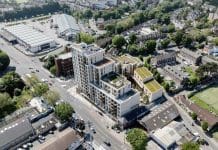Premier Guarantee has announced that it now carries out initial an early risk review for all new basement submissions to understand the risk the proposal represents for warranties as early as possible
The early risk review is done before handing the project to the warranty risk management surveyor. It is not a design evaluation or approval concerning adherence to the guidance of BS8102.
For Premier Guarantee to carry out this review, documentation must be provided by the developer at least eight weeks before the commencement of the basement to allow the evaluation of the risk to be carried out as early as possible and, where needed, alert the developer to further information required.
What technical documentation is required for a Structural Waterproofing Risk Review?
The following is the bare minimum information required to commence the risk evaluation, and as such, you may be asked to provide more depending on the complexities of your site.
1. Phase 1 & Phase 2 Geo-Environmental Assessment Reports
A Phase 1 report must be site-specific and include the following information:
- Location and site layout plans and sections indicating topography, ground levels, features such as roads, retained buildings, ponds and watercourses, presence of trees
- Geological maps (1:50,000 and 1:10,000 scale) and any documented historical geological data
- Hydrogeology and hydrology details identifying any groundwater vulnerability, aquifer status, flood risks and drainage characteristics
- Contamination or other likely contaminants based on past history due to former usage, e.g. landfill sites, scrapyards and waste processing sites
- Any recommendation for ground gas protection measures and;
A Phase 2 report or ‘ground investigation’ for the specific site must provide further detailed information for the development of the structural waterproofing designs.
Points of relevance include:
- The investigation and the methods used, such as exploratory trial pits or borehole positions, with positions clearly being shown on a drawing
- Strata profile and description
- Full description of ground characteristics, groundwater conditions and levels
- Soakage testing and water infiltration rates
- Geotechnical contamination laboratory testing
- In-situ gas testing for methane and carbon dioxide
The items listed above are related specifically to the risk evaluation of structural waterproofing. Site investigation documents may also be required for other aspects of the warranty, and in those situations, review the ‘Ground Conditions’ Section within the latest Technical Manual for further guidance.
Why is this needed?
The obvious purpose is to inform and shape the waterproofing design by identifying the risks for the specific site and the design.
- A Phase 1 or ‘desk study’ report provides an initial description of the site and any surrounding areas or features that may impact the proposed structural waterproofing designs
- A Phase 2 or ‘ground investigation’ builds on this, providing further information for the detailed development of the structural waterproofing designs.
Advantages of providing this information for review
During the warranty risk review process at the submission to warranty, the information provided by these reports establishes the decision-making process. It approaches used by the appointed Waterproofing Design Specialist. It gives insight into the fundamental characteristics of the site and how this is relatable to the proposed design philosophy.
For example, suppose the Waterproofing Design Specialist, in their design philosophy, states the site has a ‘low risk’ in relation to the water table classification. In that case, the statement should be supported by evidence in these reports.
2. General Arrangement Drawings
General arrangement drawing packages produced by the ‘design team,’ e.g. Architect, Engineer. These should include plans, elevations and sectional drawings identifying all the plots and locations of below-ground storey levels, lift pits and basements.
A Dropbox submission of the entire project is not required, rather the documents relevant to the below ground areas e.g. basements, split levels, etc. and drainage designs along with a drawing schedule relating to the submission. A drawing schedule of these specific documents would be invaluable to quickly identify which drawing provides what information.
General arrangement drawings give key information in relation to the project, such as:
- Scheme type e.g. residential, commercial, etc.
- Site topography and the interaction of the structure with that topography
- The proposed use of the space or spaces e.g. habitable space, plant rooms, lift pits, etc.
- The construction methods and type e.g. reinforced concrete retaining walls, slab construction, etc.
Advantages of providing this information for review
Providing this information establishes the fundamentals of the proposal as early as possible. It also allows PG to align the principal details to the follow on waterproofing designs.
For example, if the Architect specifies a masonry retaining wall, but the Waterproofing Design Specialist details the use of a reinforced in-situ concrete retaining wall to achieve a Type B Structurally integral protection, this would be picked up early to avoid costly issues on site.
3. A site specific waterproofing design philosophy document
A site specific waterproofing design philosophy document must be provided by a suitably qualified Waterproofing Design Specialist e.g. Certificated Surveyor in Structural Waterproofing (CSSW) using the evidence of the site investigation reports.
It should include:
- The name of the Waterproofing Design Specialist who has prepared the document, along with their credentials and relevant experience
- An index of documents used to create their document e.g. architects drawings, engineers’ drawings, titles of any assessments and report
- An outline description of the applied waterproofing principles and any referenced standards used to formulate the design e.g. BS 8102
- Clear and concise observations that are relevant to and influence the waterproofing design
For example:
– Scheme type e.g. residential, commercial, etc.
– Site topography and the interaction of the structure with that topography.
– Ground conditions on site such as geology, hydrology, and hydrogeology.
– The proposed use of the space or spaces e.g. habitable space, plant rooms, lift pits, etc.
– The construction methods and type e.g. reinforced concrete retaining walls, slab construction etc. - Precise statements in relation to the waterproofing strategy.
For example:
– A list of all spaces contained below ground, complete with a clear determination of the environmental grade required for each space e.g. Area A is habitable space and required Grade 3 protection.
– A brief statement of how that environmental grade is to be achieved for each space e.g. Space A requires combined protection, using a Type A Barrier protection and a Type B Structurally integral protection.
– A brief statement of how the environmental grade will be maintained and/or repaired in the event of a defect e.g. Space B is a plant room, requiring an environmental grade 2. The Type B Structurally integral protection system used to provide this protection will remain accessible internally for inspection and any repairs.
– The existing and proposed site levels and any features which may impact on the areas of building below ground level. - Annotated drawings in relation to the waterproofing strategy, provided by the Waterproofing Design Specialist
- A brief list of the selected products being used to deliver the strategy, inclusive of any supporting drawings in relation to detailing or interfaces with other elements e.g. penetrations, terminations above ground with cavity trays, etc.
- The extent of drainage required to support a structural waterproofing design by lowering the effects of both ground water and percolation of rainwater into the ground.
The provision of a Structural Waterproofing Design Philosophy document at this early stage is needed to ensure that an approach has been specifically designed to provide the required environmental grade based on the specific nature of the site.
The design philosophy should clearly set out how the specified design will provide the required environmental grade based on the specific hydrogeology and ground conditions of the site.
A Structural Waterproofing Design Philosophy document provides greater clarification of information
The provision of a Structural Waterproofing Design Philosophy document at this early stage is often overlooked or incorrectly considered as ‘not essential’.
However, for warranty purposes, the provision of a Structural Waterproofing Design Philosophy document by a competent person gives a greater clarity of the information, which then allows us, as early as possible, to establish the level of risk and complexity involved in the project. Where afforded the opportunity to carry out such an evaluation, issues can be avoided on site.
For example, a structural waterproofing proposal is provided in relation to an area of a plant room considered critical to the buildings operation. The design details a Grade 2 environment for this area with a single system of waterproofing protection. However, when the ground conditions are reviewed against the supporting Phase 1 and Phase 2 reports by us during the structural waterproofing evaluation process, they may be considered to present a high risk water classification.
In such an instance, PG may request the Waterproofing Design Specialist adjust their proposals to provide details of risk mitigation such as an additional system of protection to protect the environmental grade and lower the risk of failure.
4. Drainage layout drawings
Drainage layout plans showing maintainable drainage runs, access provisions and outfalls related to all drainage supplementing the structural waterproofing proposals.
The importance of this is commonly overlooked. The provision of drainage to support a structural waterproofing design is typically a method of lowering the effects of both ground water and percolation of rainwater into the ground.
Principally, if the structural waterproofing design references and details drainage, the following can be established:
- Achievable and suitable points of discharge – all drainage must terminate to a suitable outfall. This may be a detention pond, soakaway, or storm water drain via a silt trap or non-return valve
- Levels – as perforated drainage is below the invert level of a basement floor slab, it is not always possible to include it into a ‘standard’ surface water drainage plan. It may require drainage runs dedicated solely to managing ground water, and fully separate from any surface water drainage proposals
- Access and maintenance – all drainage must be maintainable so we need to see what provision for this has been made e.g. rodding points, jetting points, access chambers, etc.
- Proximity of any water detention or storage to the below ground structure – if the project has such features as detention ponds, attenuation tanks or soakaways, then we must establish what the risk or impact on the waterproofing approach is
Advantages of providing this information for review
The provision of drainage to supplement structural waterproofing, is a means of reducing the risk of failure by ensuring that the effects of water in the ground or percolating through the ground from higher levels does not stand against the structure.
Where proposals are to manage this in a controlled manner, this information is needed as soon as possible to ensure that what is being proposed can be achieved and can be maintained.
For example, a structural waterproofing design proposes the use of an external perforated drain to a soakaway provision sufficiently distanced from the structure. However, the plans do not detail any form of rodding access to the deep drain and therefore any periodic maintenance to clear silt or debris form the drain cannot be achieved.
A failure of the drain will see slowed water movement and potentially lead to a perched water table, so the design would be asked to be amended at an early stage to avoid this potential issue.
What happens next?
On conclusion of a successful review, the content is sent to the Risk Management Surveyor with identifiable warranty risk areas and guidance for their management. They review this and communicate this to the developer with whom they plan and work with to develop an inspection plan which manages those risks on site.
If the information provided is insufficient, Premier Guarantee will communicate this to the developer for their immediate attention and request further details.
If at the end of the 8 week period there is still insufficient detail to establish the risks to warranty,PG advise the appointed Risk Management Surveyor and their line manager of a need to consider the project is placed into Technical Escalation based upon a lack of design information being provided.
What is a Technical Escalation?
A Technical Escalation process is used to highlight the ongoing risk to all interested parties and inform them that by not resolving the risks could mean we may have to progress towards cancellation of the warranty.
What happens if the approach to structural waterproofing changes after a risk evaluation?
If the developer wishes to amend their proposals and any approaches to structural waterproofing aspects of their project, they should inform Premier Guarantee at the earliest possible time, as this change may create a higher risk for warranty.
Premier Guarantee will need to review the changes being proposed and this may result in the whole process having to be restarted.
Similarly, when on-site, the appointed Risk Management Surveyor will use the content of the review during their site visits. Should they become aware that the design information, products, and specification varies from those we have reviewed, it might create a higher risk for warranty.
Again, in such an instance, Premier Guarantee will need to review the changes made and this may result in the whole process having to be restarted.
Read Premier Guarantee’s latest guidance on basement submissions on the Premier Guarantee website.














